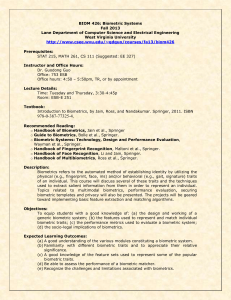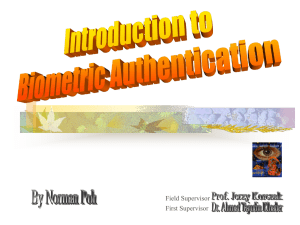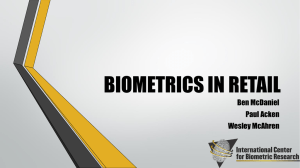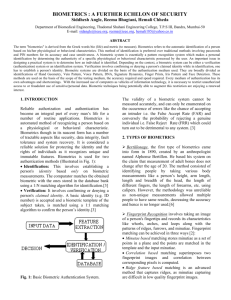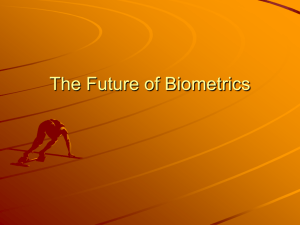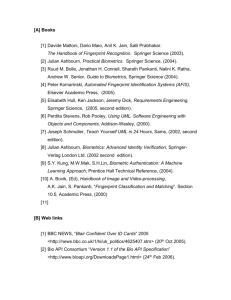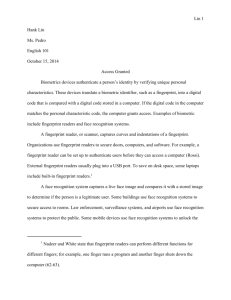Biometrics: myths and reality
advertisement
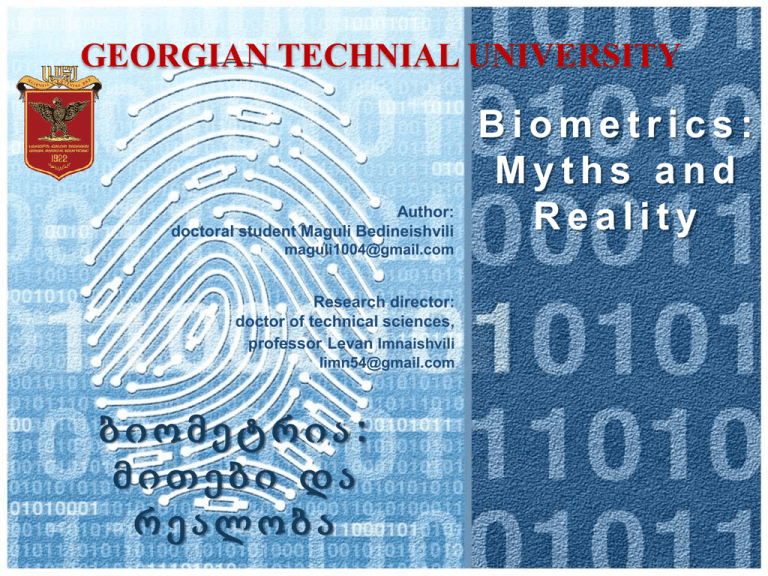
GEORGIAN TECHNIAL UNIVERSITY Author: doctoral student Maguli Bedineishvili maguli1004@gmail.com Research director: doctor of technical sciences, professor Levan Imnaishvili limn54@gmail.com ბიომეტრია: მითები და რეალობა Biometrics: Myths and Reality Definition of Biometrics Perception of "Biometrics" Traditional Static processing of biological features Modern Person identification technology, which uses human physiological features Biometric Characteristics Fingerprint Keystroke Hand Iris Signature Face Voice DNA Estimation of Biometric Features Biometric Barriers to universality Worn ridges; hard or finger impairment None Hand impairment Visual impairment Speech impairment Distinctiveness High Low Medium High Low Permanence High Medium Medium High Low Collectability Medium High High Medium Medium Performance High Low Medium High Low Acceptability Medium High Medium Low High Potential for circumvention Low High Medium Low High Actuality million. USD Revenue of Biometric Industry Information of Acuity Market Intelligence Actuality 2012-2017 Forecast of technologies development 1. 2. 3. 4. 5. Human body - energy generator; Biometrics in service of information security; Mind reading isn't already fiction; Mobile phone everywhere and in everything; Computer - personal assistant. Segment of Market Hand Hand geometry vein Voice Signature Other Iris Fingerprint 58% Face History of Biometrics Finger papillary lines: Depicted on the ancient construction by accident... Decorative, mystical elements... Person confirmation facility: China - 300 year B. C. Japan - 702 year A.D. Europe - XVII-XIX century USA - 1902 year A.D. Ireland Ancient China History of Biometrics 1858 year William Herschel: used handprint for formatting agreement Herschel's fingerprints, which was made within 57 years. 1880 year Henry Faulds: for person identification was offered using fingerprint History of Biometrics 1882 year Alphonse Bertillon processed the technique for measuring the parameters of prisoners' bodies (Bertillonage) Francis Galton created the first system of classification fingerprint Using Scopes Biometric control of physical access Biometric control of logical access Justice and law enforcement scope Accounting of working time Medical scope Border control Financial and transactional biometrics Mobile devices Biometric locks Consumer biometrics Learning institutions Other using scopes of biometrics - convenience Using Scopes Fingerprint Types Image Processing Algorithm Fingerprints characteristics The Functioning Principle of Biometric System Fingerprint pattern Fingerprint Fingerprint “map” Biometric System Implementation Ye s / N o Matcher (Threshold) Preprocessor Authentication Te m p l a t e Database Feature Extractor Preprocessor Enrollment Identification Procedure Verification Procedure Errors of Recognition Stage • FRR – False Rejection Rate The system makes decision to reject a person, in spite of that, he is already registered in the database. • FAR – False Acceptance Rate The system makes decision to accept a person, even if he isn't registered in the database. Relation of First and Second Category Errors FAR FAR FRR EER FRR Teachers Biometric Registration System Implemented in Georgian Technical University Biometric Eectoral System Implemented in Georgian Technical University Biometric accounting system of students attendance in lectures Developed in Georgian Technical University Biometric System of Students’ Admission in Examinations Developed in Georgian Technical University GEORGIAN TECHNIAL UNIVERSITY Biometrics: Myths and Reality გმადლობთ ყურადღებისთვის! Thank You for Your Attention! ბიომეტრია: მითები და რეალობა



